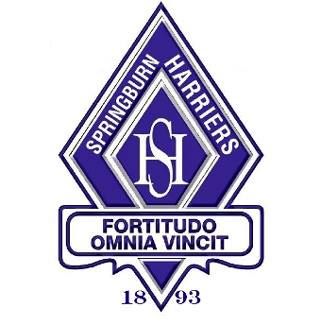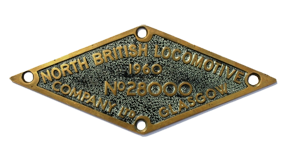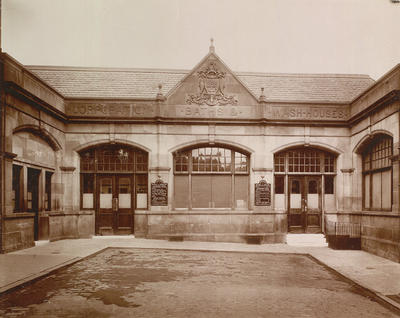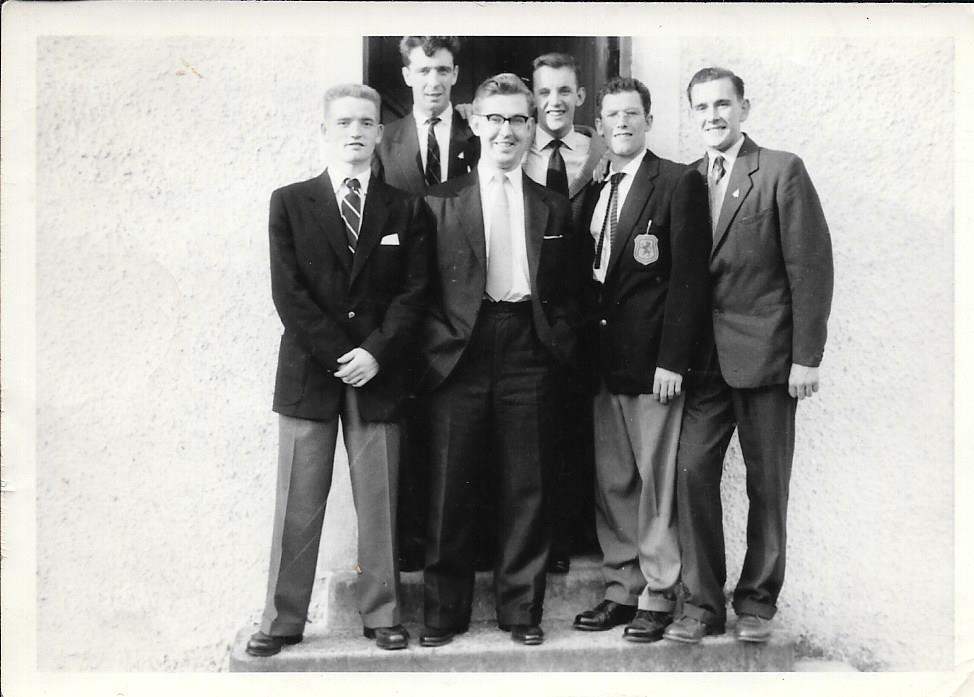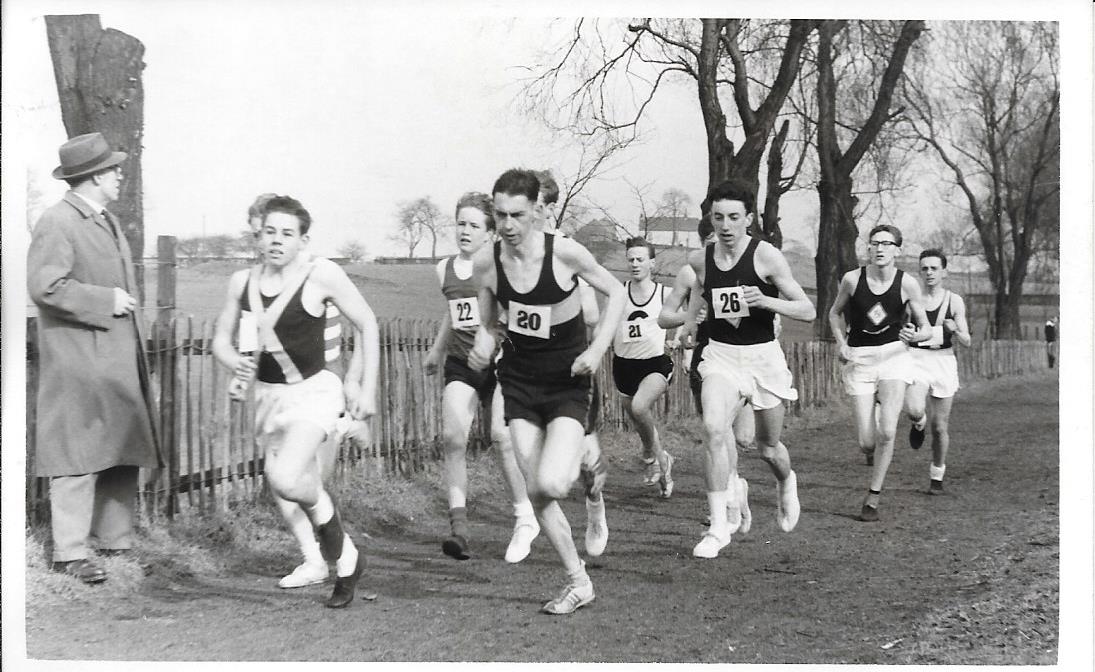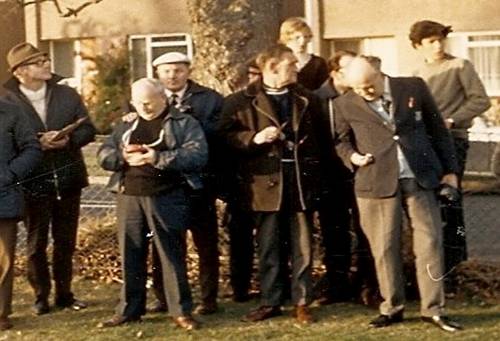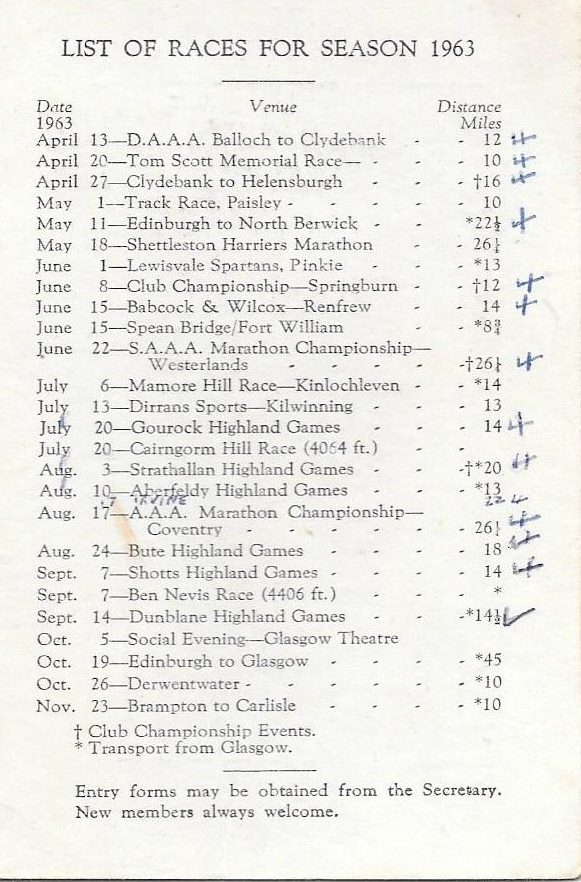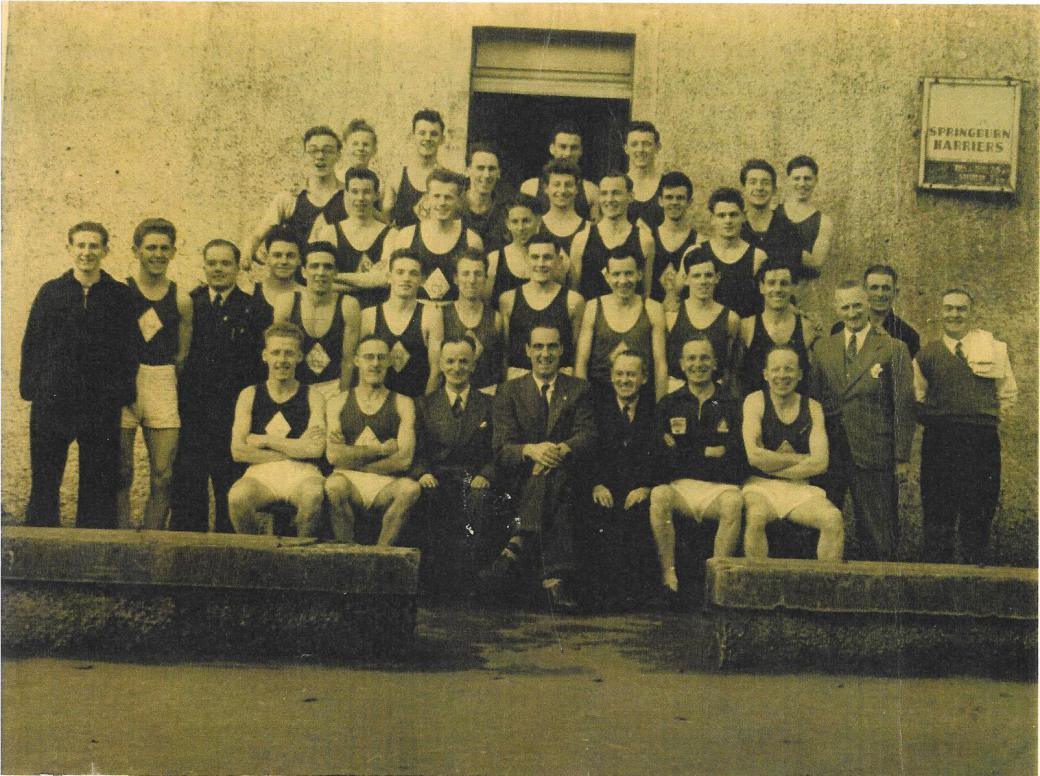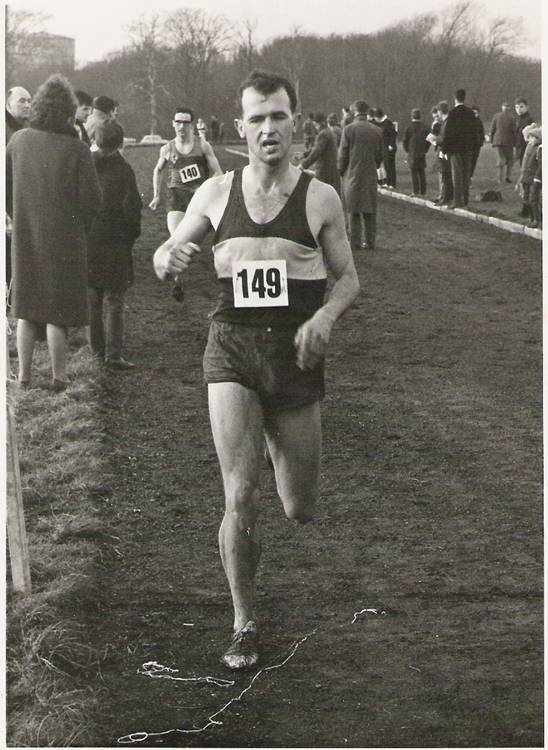There are several venues in Glasgow that are not well known at all nowadays but which in their day were the scene of some wonderful performances. One of these was the home of Springburn Harriers. Their club rooms for many years were at Auchinairn Road in Bishopbriggs.
As you can see from the crest above, the club was established in 1893 and by the first part of the 20th century it was recognised all over Scotland as a first rate club with many trophies won and international athletes produced. But why the diamond? The club website tells us that the badge and crest (above) was taken from the railway locomotive factories based in the area, and their motto means ‘courage conquers all’. Ian Young tells us that “the Diamond on the Springburn vest is a copy of the trademark of the North British Locomotive Company in Springburn which was owned by Sir Hugh Reid” . Reid was the first chairman of the North British Locomotive Works – the largest builder of steam locomotives anywhere in the world. From its headquarters in Springburn over 18,000 locomotivess were exported to all points of the compass. The diamond therefore has a real significance for the area and for the country.
Like all clubs, Springburn wanted premises of their own and, after a spell in the local Public Baths, they actually built the first club headquarters in Scotland. The better known one in Bishopbriggs was in fact the second pavilion of their own. This was opened in 1930 in Auchinairn Road, Bishopbriggs. Hut does not do it justice – a long building, slightly set back from the road, it had a feature that very few clubs possessed. It had a famous huge plunge bath in which runners from several clubs could all wash at the same time. It was unique in my experience to have this facility. However we should maybe look at the headquarters from its opening.
The Kay Street Baths in Springburn were opened in 1898 and that became the club’s chosen venue. But the one that most remember is the clubhouse at Auchinairn Road in Bishopbriggs. It was just down the hill from their current headquarters at Huntershill but was a quite different establishment altogether. There was an article about the club in the “Scotland’s Runner” magazine of May 1993 which told us that the club had left the Baths after six years and moved to Auchinairn, becomin the first club in Scotland to build its own pavilion. The club then moved to the new clubhouse in 1930.
This venue was unveiled to the athletics public, as well as the people of Bishopbriggs, in 1930 with the grand official opening on 4th October, 1930.
The ‘Glasgow Herald’ of 29th September reported on the trials of several of the teams taking part in the event which had been held on the Saturday. These included Beith, Hamilton, Shawfield, Cambuslang YMCA, Eglinton, Falkirk Victoria, Glasgow YMCA, Kilmarnock, Monkland and Motherwell YMCA Harriers. These were by no means all that would take part though. Read the report.
PLEBEIAN HARRIERS SUCCESS AT SPRINGBURN
Springburn Harriers had a big turnout at the opening of their new pavilion in Auchinairn Road, Bishopbriggs, on Saturday. The new clubhouse, which has been erected entirely by members and friends is a commodious wooden structure with a roughcast front and is situated within a short distance of the site of the club’s first pavilion, which, it is claimed, was the first to be owned by a harriers club in Scotland.
The opening ceremony was performed by Sir Hugh Reid, Bt, after which the inaugural event – a relay team contest – was decided. The race, which brought out 21 teams of four, was over a course of some two and a half miles practically all on the road. The trail lay to the south of Auchinairn Road, crossing Littlehill Golf Course and passing Stobhill Hospital.
Being the first Saturday of the season, some of the clubs were not quite at full strength, but this did not have much bearing on the result. Plebeian Harriers, a club which in recent years has been outstanding at this interesting form of athletics – they are Western District Relay champions – had out a quartette which included SK Tombe, an ex-champion of the club who last year ran for the West of Scotland Harriers. Their present champion, WJ Gunn, was not included here as he is not yet fit. The National team champions, Maryhill Harriers, had out a good four which however did not include D McLean and WH Calderwood. At the end of the first circuit Tombe had given Plebeian a lead of fully 60 yards, which margin was improved upon by other members of the team so the issue was never really in doubt. For the first three laps Shettleston lay in second but on the last round Beith, thanks to a fine effort by J Calder, displaced them. Irvine YMCA, the South Western relay champions, were fifth, a position they held at each changeover. ”
The result was a win for Plebeian Harriers in 51:54 from Beith (52 min), Shettleston (52:10), Monkland (52:35), Irvine YMCA (52:38) and Maryhill Harriers (52:40). The fastest times were by S Tombe (Plebeian) 12:30, S Anderson (Shettleston) 12:43 and J Calder (Beith) 12:45. The field had many international runners and national champions such as Tombe, Rayne (Plebeian), F Stevenson (Monkland), and D Fry (Irvine YMCA).
Some weel kent faces outside the clubhouse:
Back Row: Tom O’Reilly and Jack Crawford; Front: Eddie Sinclair, Bob Dalgleish, John McCormick and Danny Wilmoth
It was a unique headquarters – there was not another like it in Scotland and it is appropriate to describe just what it was like. The description of the building below is taken from information from Ian Young and Eddie Knox – both top class distance runners from the club who knew it well.
It was a small, brick built clubhouse owned by the Club, but sited on land rented from Glasgow Corporation Transport Department which ultimately meant they could not realise full value for it when we moved up to the Huntershill House changing rooms. Ian first ‘entered its portals’ in 1960, as a 15 year-old youth, Eddie was a bit later but their descriptions tell us that you entered straight into the main changing room which also doubled as a meeting room. It also served for social events such as small dances or even whist drives. At the back of the main room, the building was divided about one-third and two-thirds into a committee room in the smaller portion and the fabled concrete communal bath-tub and behind that, the toilets. There was a shower and the theory was that you had to shower before going into the bath. There was also an area in the rafters which was used to store club artefacts – flags, course markers, memorabilia, etc.
Ian cntinues: “Within the bathtub area, on the dividing wall with the changing room was the gas-fired geyser which had to be lit before we went out on our training runs so that the bath could be filled with hot water on our return. The lighting of this beast was a life-threatening experience since the boiler would slumber as attempts were made to light it before all of a sudden bursting into life with a resounding roar and a burst of flame which could scorch the eyebrows of the unwary. I must admit, it scared me witless and I don’t ever remember being brave enough to light it and left that task to senior members of the time such as Eddie Sinclair, Danny Wilmoth, Tom O’Reilly and others. The communal bath, unhygienic as it must have been compared to today’s standards, was nevertheless, a great social centre for chat and ribaldry which created a great bond within the club membership and our visitors. The water level rose as more people entered, endangering the lives of those younger members who were on the small side!
We were blessed as a club with a nucleus of non-competing senior members who looked after the running of the clubhouse and the club itself. Interestingly most of them also played a significant role in the SAAA or SCCU in those days, namely; Bob Dalgleish, JCR (Jim) Morton, Dr Andrew Kenny and ‘Old’ Jack Crawford. Other members from those days who were regulars in the clubhouse, not mentioned above, but whom you will probably know, include John Young and John Kerr (both sprinters but who trained on the roads with us through the winter), Moir Logie, Jim Keenan, Tom Craig, Eddie Knox, Duncan Middleton etc. We always changed our training venue in the spring to St Augustine’s High School in Milton, Glasgow for track training, where we had the advantage of pristine showers and changing rooms, but always welcomed the onset of the road-racing season and our return to the communal bath in the Auchinairn Road clubhouse!”
Eddie Knox comments on the premises: “One shower, one large communal bath which you were meant to shower before entering. However, I remember seeing a layer of mud and grass floating on the surface whilst twelve or so guys soaked some heat back into themselves. The shower came afterwards by necessity. It was built in 1930 by the members on ground rented from Glasgow Corporation. (I can only surmise that during one of the local government reorganisations this contract got lost. The ground was sold to the person who built a house there. The club was told they had no right to be there. When it was pointed out we had been paying rent for forty odd years it was claimed there was no record thereof. Fishy!)
There was a small committee room/kitchen. Occasionally tea and hot drinks were made. There was, of course, a toilet which was entered carefully because there were holes in the wooden floor which small and not so small creatures came through.”
*
The clubhouse was used for over 30 years before the Harriers moved up to Huntershill Recreation Ground where they are still in the twenty first century. Many races were held from the new pavilion but one that many remember was the Springburn Cup race for a mixed team of Boy (Under 15), Youth (Under 17), Junior (U20) and Senior Man. See the picture below from the mid-50’s: the natty gent on the left is Doc Macphail of Dumbarton. It was fairly well supported but the fields were usually small simply because of the old problem – many clubs had difficulties providing a runner from one age group or another with the lack of a Junior Man often being cause of a team not being sent. The race was fairly poplular but not as well supported as the race which followed and replaced it – a five mile open team race.
Springburn Cup Race, passing alngside Littlehill Golf Course, late 50’s
The open and team race for the Springburn Cup started in the mid-60’s and was immediately very popular with the athletes. It came after the traditional Beith and McAndrew races which heralded the new year but before the West District championships. There were times when it had to switch from that date to avoid a clash of fixtures but by and large that was the pattern. January 1966 was the first date that results are available for and the winners from following five years are as follows:
22nd Jan, 1966: 1st E Knox, Springburn; 2nd A Faulds (St Modans), 3rd H Barrow VPAAC.
14th Jan, 1967: 1st I McCafferty Motherwell YMCA; 2nd E Knox; 3rd J Brennan, Maryhill.
13th Jan, 1968: 1st: R Wedlock, Shettleston; 2nd J Brennan; 3rd P Maclagan, VPAAC.
11th Jan, 1969: 1st R Wedlock; 2nd H Gorman, Springburn.
10th Jan, 1970: 1st A Blamire, Shettleston; 2nd P Maclagan, VPAAC; 3rd E Knox.
2 Jan, 1971: 1st R Wedlock, 2nd AA Johnston, VPAAC
The race was still being described as being held at Auchinairn or Bishopbriggs in the early 1970’s and the results above indicate the calibre of athlete attracted to the events and their return, year after year, suggests that they enjoyed the atmosphere of the old clubhouse.
Officials at the finish of the SMC 12 at Huntershill
Scottish Marathon Club Fixtures for 1963
Of course in addition to these events, there were club races and the annual Scottish Marathon Club 12 miles road race held from the Pavilion. The SMC was established in 1944 with the aim of “To foster marathon running in Scotland” and they held their own championship over four races – the Springburn 12, the Clydebank to Helensburgh 16, the Strathallan 20 and the SAAA Marathon championship. The format was that the athlete had to run in three of the four races, one of which had to be the marathon. This of course helped to attract some very good runners to Auchinairn. The date for the race for most of its existence was the first Saturday in June and this pretty well held true until 1967-8 and 1968-69 when there was no race at Springburn and the SMC 12 was held at Cambuslang. It returned to Springburn in 1969-70 but on May 17th, and the date dotted about in the following years – eg in 70-71 it was May 31st, and in 1972-73 it was May 6th. The 70’s were of course the time when the ‘marathon boom’was just taking off and the fixture lists were swamped with several races most weekend. Lots of the best road runners in Scotland ran in these races and – with one exception – I remember it being blessed with good weather.
Note that in the card for 1966, the race was on 25th June and the SAAA Marathon was on 28th May – this was because the Commonwealth Games were to be held that year in Jamaica and the SAAA Marathon was to be used for selection purposes. Hence the reversal of the usual order of things. You will also note the presence of two Springburn Harriers on the Committee of the SMC.
The race that year was won by Gordon Eadie of Cambuslang Harriers in 68:34 from Hugh Mitchell of Shettleston Harriers (71:04) and Bob Anderson (Cambuslang) in 71:52. Other leading runners were, in order, Bob Calderwood (VPAAC), Jack McLean (Bellahouston) and R Burt (Cambuslang). Say what you will about the clubhouse but it fed and watered the runners, friends and officials admirably year after year.
The club eventually moved to Huntershill in 1973, the “Scotland’s Runner” article saying that it was because of financial reasons. The author goes on to say that “I remember the hut well, it had those unmistakeable running smells – of sweat, wintergreen, grass and mud. Above all else it had atmosphere, the nervous tension before training runs, which were as ruthless as races, and the banter afterwards.”
Ian Young tells us something about the move to Huntershill: “The land which the Club owned at Huntershill was gifted to Bishopbriggs Town Council which came into being in 1964, to build a playing field and athletics track, in return for a sole right of use of the changing facilities in Huntershill House and the track for training on Tuesday and Thursday evenings in perpetuity.”
That was the kind of agreement that any club would welcome – somewhere to train in perpetuity – and with changing and showering accommodation too!
Allan Faulds (Stirling) finishing the Springburn Cup race at Huntershill
